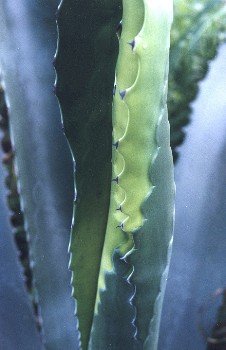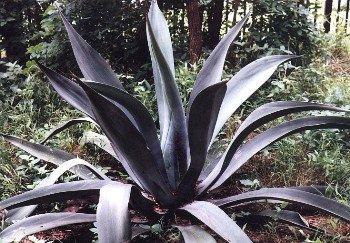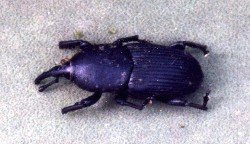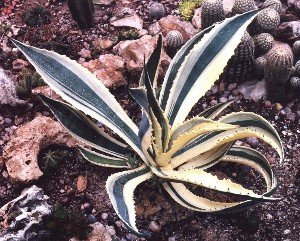Agaves
by Valerie (August 7, 2001)

Among the various agaves that we grow in our gardens, two species are impressively large. These are the ones commonly called century plants because they take 15 to 35 years before blooming.
While xeriscaping the front part of our yard, we bought four small bluish-gray colored agave plants. These are mescal, or Palmer, agaves (Agave palmeri), a native of Arizona and New Mexico. They do very well for us and are quite freeze hardy. Their 3-foot long leaves have a fine sand-paper like texture, and tend to be more gray colored than green. They are favorite perches for praying mantises and green anoles.
This past spring, one of the large plants suddenly started to wilt. Closer inspection (which involved pulling off a couple of 20 pound leaves) revealed that the entire heart of the plant was brown, rotted and infested with large black weevils (pictured above at right). The plant could not be salvaged and we removed it. The same fate befell the other mescal agave located a few feet away. So far, no other agave species have been affected. Also, the young plants continue to be healthy, as well as the plants on the other side of the driveway.
Now that the two biggest plants are gone from one small garden, there is plenty of room for another agave growing there. This is a yellow and green variegated agave (Agave americana) of the type commonly used in Florida for landscaping. Although still a large plant, this species does not grow as fast, is not as hardy, and produces fewer offshoots. Its leaves are flatter and more flexible. We have transplanted several of the young plants to other areas and they are doing well, although they tend to suffer some damage during the winter. One larger plant also died of unknown causes. Although we may not live here long enough to witness it, I would love to see one of our large agaves bloom.
A beautiful and gardener-friendly agave is shown in the last photo here. An unidentified species, it is growing at Zilker Gardens in Austin. It is very large, but its most striking feature is the lack of thorns on its leaves. The leaves are smooth and glossy and utterly devoid of dangerous spines.  |
 The tip of each leaf has a 2-inch brown spine that is very sharp. Each plant has produced dozens of offshoots in the past 13 years or so. When new leaves form, they emerge from the center and gradually unroll in an interesting and symmetrical way.
The tip of each leaf has a 2-inch brown spine that is very sharp. Each plant has produced dozens of offshoots in the past 13 years or so. When new leaves form, they emerge from the center and gradually unroll in an interesting and symmetrical way.
